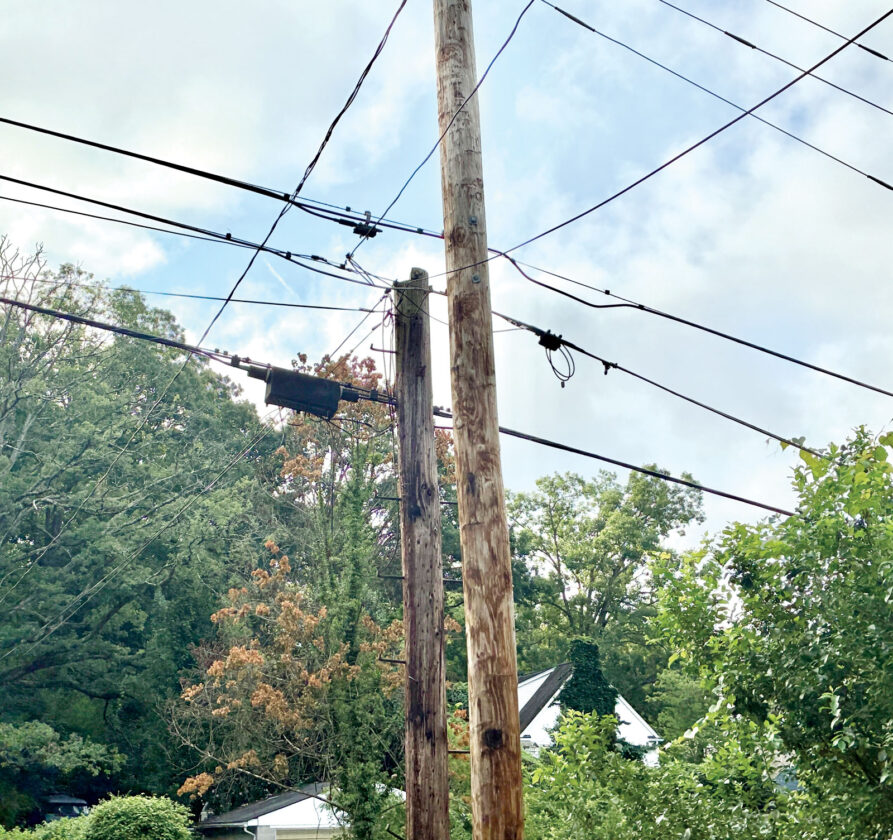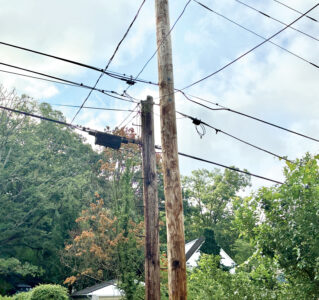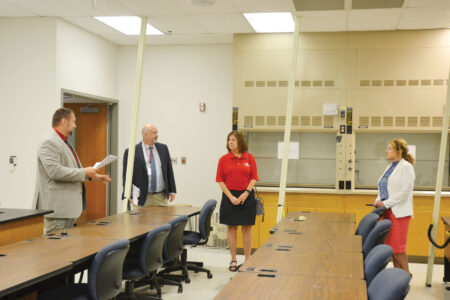PSC sides with internet service provider in broadband pole attachment issue

The issue of who pays for pole replacements, the electric utility or the internet service provider attaching new broadband equipment, is at the heart of an order issued Monday by the West Virginia Public Service Commission. (Photo by Steven Allen Adams)
By STEVEN ALLEN ADAMS
sadams@newsandsentinel.com
CHARLESTON — The West Virginia Public Service Commission is taking the side of an internet service provider in a dispute over who pays for pole replacements when adding broadband attachments.
In an order issued Monday, the PSC prohibited Appalachian Power from enforcing a “pre-existing violation” policy to place the cost of repairs or replacement of utility poles on internet service providers, instead of the electric utility that owns the poles.
Appalachian Power has cited its pre-existing violation policy when issues are discovered with the pole or prior attachments to the pole during make-ready, the process of modifying utility poles for new ISP equipment.
The PSC ordered Appalachian to comply with its rules regarding pre-existing violations when it comes to pole attachment applications submitted by Comcast Cable Communications. The two companies were also ordered to meet and file a future timeline for make-ready completions.
Current laws prohibit pole owners from denying access to utility poles to new attachers, such as ISPs, due to safety concerns stemming from pre-existing code violations caused by other attachers.
A 2023 order issued by the Federal Communications Commission also determined that pole owners cannot charge new attachers for replacements of utility poles due to pre-existing conditions on the pole, if the pole is already scheduled for replacement or if the pole is non-compliant with safety standards.
Comcast filed its pole attachment complaint with the PSC on May 22. Attorneys for Comcast claimed that Appalachian Power’s pre-existing violation policy violated PSC pole attachment rules, causing delays in new broadband deployment; created unjust and unreasonable terms and conditions; and caused Comcast to not complete make-ready construction within timeframes required by the PSC rules.
“The language of Pole Attachment Rule 10.4.4 clearly states a pole owner may not charge a new attacher to bring pole into compliance if the pole is out of compliance because of work performed by a party other than the new attacher prior to the new attachment,” the PSC wrote.
The issue of who is responsible for pole repairs and replacements is one of the several at the heart of disagreements between ISPs and electric utilities. Bridgeport-based Citynet is having a similar dispute with Akron-based FirstEnergy subsidiaries Mon Power and Potomac Edison over grandfathering.
Attorneys for Appalachian Power filed a motion to stay a PSC ruling on July 16, after PSC staff filed a petition to reopen an earlier case involving the pole attachment issues in order for the commission to further consider pre-existing violations.
“Given the importance of resolving pre-existing violations on utility poles to expeditious broadband deployment in West Virginia, APCo agrees with Staff that pole owners’ treatment of pre-existing violations warrants the kind of careful consideration and deliberation possible during the Rulemaking process,”the company’s attorneys wrote.
“A ruling in the present case is not proper at this time … and will thus be undertaking a lengthier and more deliberate process to establish general rules regarding with respect to how utilities handle pre-existing violations in the course of the pole attachment process,” the attorneys continued.
The PSC issued an order on June 27 establishing a Pole Attachment Working Group to address various issues, including make-ready timelines, cost allocation and rule updates. The Commission mandated the creation of a pole inspection database to aid broadband providers, contingent on funding, and required pole owners to file annual reports on attachment requests. The order also addresses specific rule modifications, such as allowing temporary pole attachments during pole replacements.






